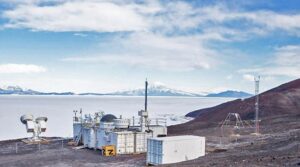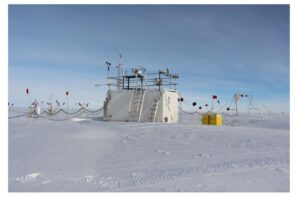McMurdo Station (WAP USA-22), where the ARM Facility’s most advanced  cloud and aerosol instrumentation, has a meteorological relationship with the West Antarctic Ice Sheet (WAIS) via circulation patterns in the Ross and Amundsen seas.
cloud and aerosol instrumentation, has a meteorological relationship with the West Antarctic Ice Sheet (WAIS) via circulation patterns in the Ross and Amundsen seas.
From McMurdo, the second ARM Mobile Facility (AMF2) gathered sophisticated data with cloud radars, high-spectral-resolution lidar, and a complete aerosol suite with relevance to the WAIS Divide Camp (WAP USA-34) as well.
Figure aside. The “skip container” housing the AWARE Extended Facility instruments at the WAIS Divide Ice Camp (WAP USA-34)
Read more at: https://www.arm.gov/publications/programdocs/doe-sc-arm-17-028.pdf
The U.S. Department of Energy’s Atmospheric Radiation Measurement (ARM) Climate Research Facility maintains field sites in the Southern Great Plains, the North Slope of Alaska and the Tropical Western Pacific, plus an aerial facility, to obtain continuous measurements of cloud and radiative properties for improving climate models. In addition to these fixed sites, two mobile facilities provide flexible instrument platforms for conducting atmospheric experiments lasting from 6 to 12 months, anywhere in the world.
The purpose of the AMF Is to collect essential Information about cloudy and clear atmospheres in under-sampled climatically important regions. In some of these regions even the macroscopic deed structure is relatively unknown. The AMF produces data sets for use by the atmospheric community to test and improve parametrizations in global climate models.
Data from the AMF are processed and evaluated for overall quality by scientific staff. Algorithms may be developed to create higher-level data products for specific science needs. Data from the AMF are made available to the community in near real time
Each deployment is the result of a competitive process based upon scientific proposals submitted by learns of scientists. The ARM Climate Research Facility’s Science Board reviews proposals for using the AMF in order to maximize the science return within the budget allotted to the program. All data collected by ARM are freely available from the data archive at: www.archive.arm.gov
Thanks and credit to: The U.S. Department of Energy’s Atmospheric Radiation Measurement (ARM)
“Image courtesy of the U.S. Department of Energy Atmospheric Radiation Measurement (ARM) user facility.”
